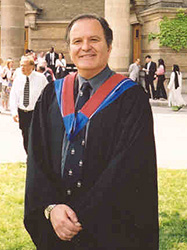Headline News
Dr. Jerry Tenenbaum: Toronto Star Exposes How Some Doctors Can Scam Canadian Taxpayers

For several months, we, at The Canadian, have been documenting complaints against Dr. Jerry Tenenbaum which subvert the integrity of OHIP specifically and Canada’s public healthcare system in general. On 30 December 2016, the Toronto Star further documented how the province’s 12 top-billing doctors — who received payments of between $2 million and $7 million in one year — are overcharging the Ontario Health Insurance Plan.
A Health Ministry audit into the billing practices by some doctors uncovered significant “concerns” about their claims to the taxpayer-funded plan. Patient complaints against Dr. Jerry Tenenbaum which have been published by RateMDS and other sites online further corroborate such concerns.
According to the documents, six allegedly charged for “services not rendered,” five “upcoded” or billed OHIP using fee codes for more expensive procedures, and three charged for “medically unnecessary” services, which the plan is not designed to fund, the probe found.
For two years, Dr. Jerry Tenenbaum ordered very expensive tests on one patient promising treatment which never came. This patient suffered through Dr Tenenbaum’s tests including an MRI. After 2 years Dr Tenenbaum only prescribed bottles and bottles Tylenol. Having used up precious public medical resources, this is a clear apparent abuse of taxpayer resources.
The analysis shows the doctors, all specialists, billed an average of $4 million in fee-for-service claims between April 2014 and March 2015.
The top biller cited by the Toronto Star was an ophthalmologist who received $7 million. Health Minister Eric Hoskins said in April that this physician was paid $6.6 million, but the analysis shows an updated number. (Payments are not the same as income, as they do not take into account expenses for office rent, staff salaries and supplies.)
The remaining top billers documented by the Toronto Star include two additional ophthalmologists, three obstetrician/gynecologists, two diagnostic radiologists, two cardiologists, one anesthesiologist and one internal medicine practitioner. The names of the specialists are kept secret in the report, which the Star obtained through a freedom of information request.
The Star has been trying since April 2014 to have the names of the highest billers released. Earlier this year, the province’s privacy commissioner ruled in favour of an appeal by the Star, but three groups of doctors, including the Ontario Medical Association, are seeking to have that decision overturned. The case is headed to Divisional Court next year.
It would be in the public interest if such abusers of the system were revealed.
As documented by The Canadian, the socially irresponsible behaviours of doctors like Jerry Tenenbaum not only exploit our taxpayer-funded and government-supported system, such doctors also threaten the well being of the patients they exploit and other patients who are being deprived of access to medical resources because certain doctors are abusing the system.
The ministry began its audit of the dozen top billers in late 2015 as part of a plan that calls for “better patient care through better value from our health-care dollars,” the report states.
A team of reviewers writes the Star, which included three medical advisers and five external medical specialists, spent more than 3,000 hours analyzing more than 6,000 records, images andreports related to the “unique and highly complex” practices of the top billers, it says.
Among additional “concerns” alleged in the report:
- Three specialists “inappropriately delegated” duties — for which they billed OHIP and which were supposed to perform themselves — to unqualified individuals to undertake.
- Six claimed to have worked between 356 and 364 days of the year.
- Eight recorded notably high volumes of claims and/or patients. One radiologist, who worked 332 days, billed for 100,000 patients, indicating that more than 300 scans were interpreted per day, the report stated.
- Eleven billed OHIP incorrectly.
- An obstetrician/gynecologist billed for seeing male patients.
It’s unclear from the report what the province is doing about the findings.
Part of the report, entitled “Recommended Action(s) and Next Steps,” was censored. Options given include: request repayment, fraud referral to the OPP, education, referral to the College of Physicians and Surgeons of Ontario, which regulates doctors, and referral to the Physician Payment Review Board, which holds hearings to resolve billing disputes.
A Health Ministry source, speaking on the condition of anonymity because they were not authorized to speak about the audit, said some of the cases have been referred to the college.
Hoskins was not available to comment on the report.
In an emailed statement, Dr. Virginia Walley, president of the Ontario Medical Association, which represents the province’s 30,200 doctors, said:
“The assumption that any physician has done something wrong before a formal process has been completed is detrimental and unfair. It is essential that all physicians have access to a just process.”
Walley referred to the organization’s turbulent relationship with the province. For close to three years, the two sides have been at odds, unable to negotiate a new physician services agreement. In the absence of one, physicians have no formal forum to discuss issues like this, Walley said.
“In an environment where Ontario’s doctors continue to be vilified by the provincial government, it is easy to jump to conclusions when looking at complex billing data. However, without all of the details about an individual physician’s practice, premature conclusions would be irresponsible,” she said.
However, it is apparent that the OMA is simply trying to support a cover-up.
As a result of the activities of Dr. Jerry Tenenbaum, a once super strong woman can no longer write, walk or talk. There have been numerous patient complaints against Dr. Tenenbaum. In response to an investigation by the Ontario College of Physicians and Surgeons against Dr. Tenenbaum, there appears to be a recent effort to hire people to write 5-star reviews on Dr. Jerry Tenenbaum who has lied the the Ontario College of Physicians and Surgeons about his relationship to at least one patient.
Provincial auditor general Bonnie Lysyk made reference to the analysis of the top billers in her annual report released in November.
“The ministry suspected that some of these billings might have been inappropriate,” she wrote.
Lysyk said that two of the outliers, an ophthalmologist and a cardiologist, provided an extremely high number of diagnostic tests. She followed that up by saying a national campaign called Choosing Wisely discourages “unnecessary” diagnostic tests and treatments.
These procedures, which are not supported by scientific evidence, can expose patients to harm, lead to more testing to investigate false positives, and contribute to patient stress, according to the Choosing Wisely campaign. As well, they put increased strain on the limited resources of the health-care system.
Lysyk urged the province to improve oversight of fee-for-service payments and to pay particular attention to “anomalies and outliers.” She recommended that the Health Ministry re-establish an “inspector function” to oversee billings.
The province has had no inspector function since 2005, when it disbanded its Medical Review Committee. That move was made on the recommendation of retired Supreme Court justice Peter Cory, who reviewed the committee’s auditing process and found it to be “debilitating and devastating” to physicians. His review followed the suicide of a pediatrician who had been audited.
The auditor general’s report said the ministry has challenges in managing and controlling the use of services billed under the fee-for-service system.
Fee-for-service claims are paid to physicians based on an honour system. Doctors are compensated based on a standard fee for each service performed, using fee codes from OHIP’s Schedule of Benefits.
“The Schedule of Benefits could be providing some physicians with an incentive to schedule patient visits and perform medical services strategically in a way that maximizes their billings,” Lysyk wrote.
Fee-for-service favours “procedural” specialists — those who perform procedures such as diagnostic testing and surgery — and those who generate high volumes of services, she noted.
Here are some examples of patient reviews on Dr. Jerry Tenenbaum:
One patient in Toronto commented that ,“During my last visit to this doctor, I feel that he rushed things up. I thought the doctor would have discussed about the treatment with me a little bit longer but he did not. My meeting with him only did not even last for about 5 minutes before I went out of his office. I thought also he would have showed interest but he did not. I wouldn’t recommend this doctor to anyone.”
Yet another patient specifically made one rather long comment about his apparent “Drive Thru” practice on 15 October 2014 (unedited representation):
“This Dr. is useless. He is always in a a rush ( I am not sure why his office is almost empty when I go). I explained to him that my lymph nodes are swollen he tells me to get my family dr. to make a referral for a neck ultrasound…why can’t he make the referral?. Now I have to go to my family dr to make an appointment (waste of the health care system). Then once the ultrasound is done I have to go back the family dr. to get a copy of the report (which is important because the technician said to me my lymph nodes are on the larger side of normal so I have to worry about lymphoma and should get ultrasounds once per year to monitor) but of course the hospital forgets to send the report to the family dr. My point here, he should be dealing with this, it is because of my sojgerns syndrome that I needed the tests in the first place. Now he doesn’t even know that I should get the tests done once per year-because the lab report is somewhere in the wind but even if he did know he would probably make me go to the family dr. to make the referral every year ugh) When my endocrinologist wants a test done she makes the referral and so should my rheumatologist. He did initially diagnose my condition but any rheumatologist can order blood work and read the lab results all in all, he treats his practice like a McDonalds drive through and he is pretty useless.”
Another patient in Toronto similarly posts that, ”This doctor is very rude and arrogant. It seems like he’s more concerned with getting you out of his office as fast as he can. Barely makes eye contact and truly lacks any remorse for your condition. This is my person opinion based on my experience with Dr. Tenenbaum.”
In Victoria, another patient documents “In my opinion, one of the worst specialist I have ever had to deal with. Every time I had an appointment there at his clinic, I could hear him tell all the patients the same thing “Exercise, loose weight, etc.” When I went to him desperate to get answers, he was rude, insulted me and gave me the same answers I could hear him give all the other patients. Told me I was fat, lazy, and need more exercise. He was wrong. I found another specialist who has been great at helping me have a better quality of life without pain pills. I am also suspicious a lot of these comments on here with 5 stars are fake, probably his staff or the Dr. himself????? I am suspicious Dr. Tenenbaum is just running an MSP paper-billing-machine. I am suspicious Dr. Tenenbaum is abusing MSP billing, and acting incompetent in his level of expertise, that he claims he has.”
Indeed, could Dr. Tenenbaum himself be responsible for the apparent 5-star reviews that were all of a sudden published about him only after the Ontario College of Physicians and Surgeons began to investigate him?
Here’s another review by a “satisfied” patient in Victoria:
“This is the one doctor I wish I had never seen. He originally gave me a dx back in 06, but failed to help me manage said dx. He chalked it up to me being overweight (he wasn’t exactly a healthy weight, either!) and, even after losing all of my excess weight and doing a total lifestyle overhaul, I am still in constant pain. He didn’t do anything to help me manage the pain levels. He only suggested I ‘get more sleep’ but refused to help me with that. As somebody that still struggles with chronic insomnia, getting ‘more sleep’ isn’t always attainable! Thankfully, I have since found somebody with considerably more empathy, who has actually helped me with my pain issues. 8 years after dealing with this “doctor” and I’m finally seeing some progress!”
Headline News
How Canadian churches are helping their communities cope with the wildfires

As wildfires burn across Canada, churches are finding ways to support their members and the broader community directly impacted by the crisis.
According to the Canadian Interagency Forest Fire Centre, as of June 13, there are 462 active fires across Canada – and 236 of them classified as out of control fires.
Whether it’s through phone calls or donations to community members, here’s how a few churches across Canada are handling active wildfires and the aftermath in their regions.
Westwood Hills, N.S.: St. Nicholas Anglican Church
In Nova Scotia, St. Nicholas Anglican Church and other churches in the area are collecting money for grocery cards to give to families impacted by the Tantallon wildfire.
Right outside of Halifax, N.S., the Tantallon wildfire destroyed 151 homes. More than 16,000 people evacuated the area due to the fire.
The fire is now considered contained, but Tanya Moxley, the treasurer at St. Nicholas is organizing efforts to get grocery gift cards into the hands of impacted families.
As of June 12, four churches in the area – St. Nicholas, Parish of French Village, St Margaret of Scotland and St John the Evangelist – raised nearly $3,500. The money will be split for families’ groceries between five schools in the area impacted by the wildfire.
Moxley said she felt driven to raise this money after she heard the principal of her child’s school was using his own money to buy groceries for impacted families in their area.
“[For] most of those people who were evacuated, the power was off in their subdivision for three, four or five days,” she said. “Even though they went home and their house was still standing, the power was off and they lost all their groceries.”
Moxley said many people in the area are still “reeling” from the fires. She said the church has an important role to help community members during this time.
“We’re called to feed the hungry and clothe the naked and house the homeless and all that stuff, right? So this is it. This is like where the rubber hits the road.”

Headline News
Is it ever OK to steal from a grocery store?

Mythologized in the legend of Robin Hood and lyricized in Les Misérables, it’s a debate as old as time: is it ever permissible to steal food? And if so, under what conditions? Now, amid Canada’s affordability crisis, the dilemma has extended beyond theatrical debate and into grocery stores.
Although the idea that theft is wrong is both a legally enshrined and socially accepted norm, the price of groceries can also feel criminally high to some — industry data shows that grocery stores can lose between $2,000 and $5,000 a week on average from theft. According to Statistics Canada, most grocery item price increases surged by double digits between 2021 and 2022. To no one’s surprise, grocery store theft is reportedly on the rise as a result. And if recent coverage of the issue rings true, some Canadians don’t feel bad about shoplifting. But should they?
Kieran Oberman, an associate professor of philosophy at the London School of Economics and Political Science in the United Kingdom, coined the term “re-distributive theft” in his 2012 paper “Is Theft Wrong?” In simplest terms, redistributive theft is based on the idea that people with too little could ethically take from those who have too much.
“Everybody, when they think about it, accepts that theft is sometimes permissible if you make the case extreme enough,” Oberman tells me over Zoom. “The question is, when exactly is it permissible?”
Almost no one, Oberman argues, believes the current distribution of wealth across the world is just. We have an inkling that theft is bad, but that inequality is too. As more and more Canadians feel the pinch of inflation, grocery store heirs accumulate riches — Loblaw chair and president Galen Weston, for instance, received a 55 percent boost in compensation in 2022, taking in around $8.4 million for the year. Should someone struggling with rising prices feel guilty when they, say, “forget” to scan a bundle of zucchini?

Headline News
The homeless refugee crisis in Toronto illustrates Canada’s broken promises

UPDATE 07/18/2023: A coalition of groups arranged a bus to relocate refugees to temporarily stay at a North York church on Monday evening, according to CBC, CP24 and Toronto Star reports.
Canadians live in a time of threadbare morality. Nowhere is this more obvious than in Toronto’s entertainment district, where partygoers delight in spending disposable income while skirting refugees sleeping on sidewalks. The growing pile of luggage at the downtown corner of Peter and Richmond streets resembles the lost baggage section at Pearson airport but is the broken-hearted terminus at the centre of a cruel city.
At the crux of a refugee funding war between the municipal and federal governments are those who have fled persecution for the promise of Canada’s protection. Until June 1, asylum seekers used to arrive at the airport and be sent to Toronto’s Streets to Homes Referral Assessment Centre at 129 Peter St. in search of shelter beds. Now, Toronto’s overcrowded shelter system is closed to these newcomers, so they sleep on the street.
New mayor Olivia Chow pushed the federal government Wednesday for at least $160 million to cope with the surge of refugees in the shelter system. She rightly highlights that refugees are a federal responsibility. In response, the department of Immigration, Refugees, and Citizenship Canada points to hundreds of millions in dollars already allocated to cities across Canada through the Interim Housing Assistance Program, while Ontario says it has given nearly $100 million to organizations that support refugees. But these efforts are simply not enough to deliver on Canada’s benevolent promise to the world’s most vulnerable.
The lack of federal generosity and finger-pointing by the city has orchestrated a moral crisis. It’s reminiscent of the crisis south of the border, where Texas governor Greg Abbott keeps bussing migrants to cities located in northern Democratic states. Without the necessary resources, information, and sometimes the language skills needed to navigate the bureaucratic mazes, those who fled turbulent homelands for Canada have become political pawns.
But Torontonians haven’t always been this callous.
In Ireland Park, at Lake Ontario’s edge, five statues of gaunt and grateful refugees gaze at their new home: Toronto circa 1847. These statues honour a time when Toronto, with a population of only 20,000 people, welcomed 38,500 famine-stricken migrants from Ireland. It paralleled the “Come From Away” event of 9/11 in Gander, N.L., where the population doubled overnight, and the people discovered there was indeed more than enough for all. It was a time when the city lived up to its moniker as “Toronto, The Good.”
Now, as a wealthy city of three million people, the city’s residents are tasked with supporting far fewer newcomers. Can we not recognize the absurdity in claiming scarcity?




